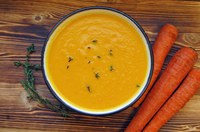Prairie Fare: Can You Guess the Vegetable?
(Click an image below to view a high-resolution image that can be downloaded)
By Julie Garden-Robinson, Food and Nutrition Specialist
NDSU Extension
Let’s see if you can guess one of America’s favorite vegetables with a few clues.
- On average, Americans eat nearly 9 pounds of this vegetable per year.
- The first varieties of this vegetable were purple. Now, more than 100 varieties exist in a rainbow of colors.
- This vegetable is in the same family as dill and cilantro.
- Most of these vegetables are grown in China.
Have you guessed yet? Here are a few more clues:
- You may find these prewashed and cut in bags or whole, with their green stems attached.
- Their name is similar to the pigment they contain.
- Bugs Bunny is their biggest fan.
Yes, today’s topic is carrots.
Horticulture enthusiasts will know that carrots are “biennial plants.” They take two years to complete their biological life cycle. Carrots produce their “tap roots” in year one and their flowers and seeds in year two.
Carrots are notably high in beta-carotene, a pigment that our body converts to vitamin A. One medium carrot has just 25 calories, plus fiber, calcium, potassium, phosphorus, vitamin K and other nutrients.
Even better, their slightly sweet flavor attracts kids and adults. As I recall from my own kids, babies probably are more likely to smile when they are introduced to this vegetable than, say, green beans.
However, be aware that overconsumption of carrots and other highly pigmented orange vegetables could turn the palms of your hands and the soles of your feet orange.
I had a friend in college who was a smoker and decided to quit. Instead of having a cigarette break, she had a large carrot to occupy her hands. As the weeks wore on, her hands and complexion began looking increasingly orange, kind of like an “oompa loompa” from the Willie Wonka movie.
My friend wore a white lab coat, so her orange complexion was especially vivid. The clinical name for this is “carotenemia.”
Fortunately, having skin with an orange tint from eating a lot of carrots does not have long-term health effects. She added other vegetables to her regimen and her skin color returned to normal. Plus, she stopped smoking, which was the ultimate goal.
While you can’t “overdose” on carrots, you can get too much vitamin A in your diet. If you take a vitamin supplement, aim for no more than 100% of the recommended daily value or follow your health-care provider’s recommendations.
Eating more carrots, and vegetables in general, is good for us, just like Mom said. Vitamin A promotes healthy skin and mucous membranes. Carrots’ potassium content is good for your blood pressure and overall heart health.
Carrot fiber is good for your digestion. Other research has shown that antioxidant-rich, highly pigmented vegetables may reduce our risk for certain types of cancer.
What about vision? Weren’t we always told to eat our carrots for good eyesight?
Oh, yes, carrots also are good for your eyes. Worldwide, a lack of vitamin A is a leading cause of blindness among children who are deficient in vitamin A.
However, you won’t be able to throw away your glasses because you include carrots to your diet. Having adequate amounts of vitamin A in our diet helps us see better in the dark. Your vision won’t suddenly improve if you have carrots for a snack, though.
Enjoy more carrots in various forms. For convenience, you might opt for “baby carrots.” These are actually full-sized carrots that have been peeled and cut to a size of about 2 inches long. They also are bred to be smaller and sweeter.
Originally, an ingenious farmer began cutting the misshapen carrots harvested from his field into more uniform sizes and shapes. An industry was born.
Of course, you can buy full-sized carrots and cut them however you would like.
Enjoy carrots in traditional ways, such as soups, stews or surrounding a roast. Try roasting carrots with potatoes, beets and other root vegetables with a small amount of oil and your seasonings of choice for a side dish. Shred them on salads or add them to stir-fry.
Have you ever tasted carrot soup? This was a personal favorite of mine during recipe testing; the pear adds flavor and sweetness. I’m surprised my skin didn’t turn orange due to the number of servings I ate.
Roasted Carrot and Pear Soup
4 c. carrots, peeled and cut
2 pears, peeled and cut
2 Tbsp. olive oil
1/4 tsp. salt
1 medium yellow onion, chopped
1 large garlic clove, minced
1 tsp. grated fresh ginger
6 c. vegetable stock
2 sprigs fresh thyme (used in roasting pan)
Optional: fresh thyme to garnish
Preheat oven to 400 F. In a large bowl, toss carrots and pears with olive oil, salt and thyme sprigs. Place the mixture in a shallow roasting pan with cover. Roast for 40 minutes or until tender, stirring halfway through cooking. When the carrot mixture is almost ready, place a large soup pot over medium heat. Add oil and onions, and cook until tender. Stir in garlic and ginger, and cook for one minute, stirring constantly. Add the roasted carrots and pears to the soup pot, discarding the thyme stems. Add the vegetable stock and bring to a boil. Reduce heat and simmer for 10 to 15 minutes, until carrots are soft. Use a blender or immersion blender to puree the soup until smooth.
Makes eight (1-cup) servings. Each serving has 90 calories, 3.5 grams (g) fat, 16 g carbohydrate, 1 g protein, 4 g fiber and 120 milligrams sodium.
(Julie Garden-Robinson, Ph.D., R.D., L.R.D., is a North Dakota State University Extension food and nutrition specialist and professor in the Department of Health, Nutrition and Exercise Sciences. Follow her on Twitter @jgardenrobinson)
NDSU Agriculture Communication - Feb. 6, 2020
| Source: | Julie Garden-Robinson, 701-231-7187, julie.garden-robinson@ndsu.edu |
|---|---|
| Editor: | Ellen Crawford, 701-231-5391, ellen.crawford@ndsu.edu |



